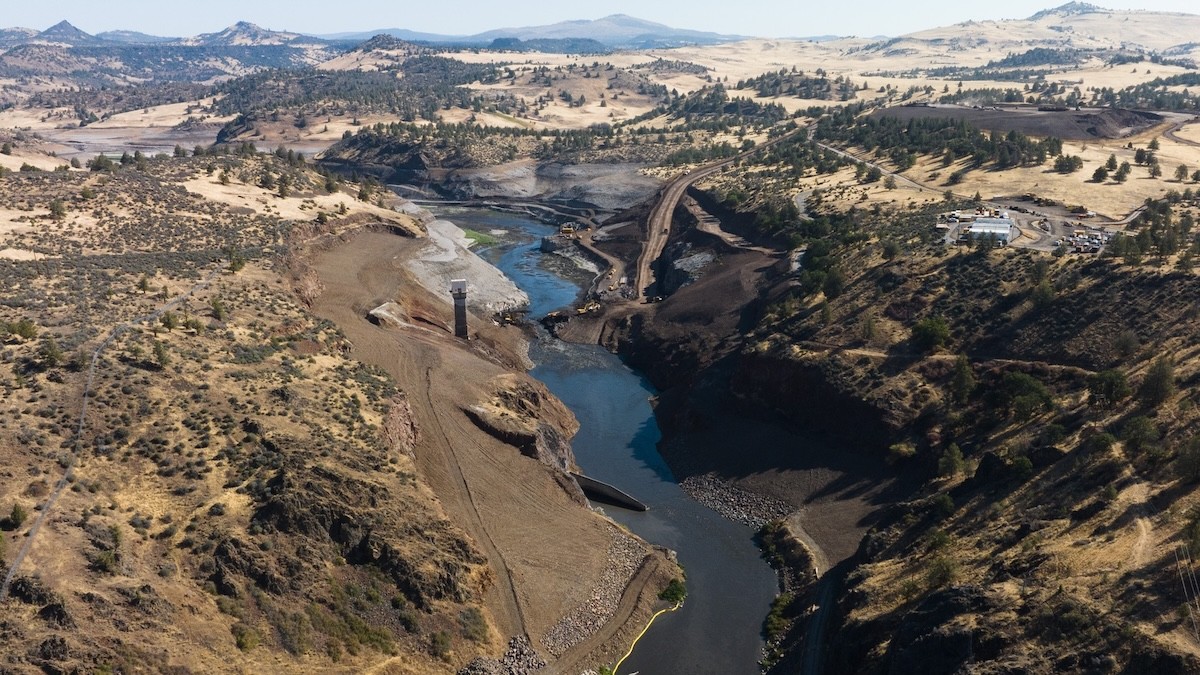
This month, the lower 200 miles on one of the most productive salmon rivers on the West Coast is flowing free for the first time in over a century. At the end of August, two major dams were breached on the Klamath River, marking the end of a massive, four-dam removal project that’s been in the works for 20 years.
“The dams that have divided the basin are now gone and the river is free,” Frankie Myers, vice chairman for the local Yurok Tribe, told American Rivers when the last of dams were breached. “Our sacred duty to our children, our ancestors, and for ourselves, is to take care of the river, and today’s events represent a fulfillment of that obligation.” For years, the Yurok Tribe led the push for the dam removals on the Klamath, which begins in southcentral Oregon but flows through a large portion of the tribe’s reservation before terminating on the northern California coast.
The dams—J.C. Boyle, Iron Gate, Copco 1, and Copco 2—were constructed on the river between 1918 and 1962, primarily for the purpose of hydroelectric power. In the years since, however, the infrastructure has aged to the point that it’s hardly profitable for PacifiCorp, the regional utility, to maintain them. Additionally, the utility was recently facing the prospect of pouring hundreds of millions of dollars into the dams to bring them up to code with modern environmental standards. None of them were built with fish ladders. (It’s worth noting that two other dams further upriver on the Klamath both have fish passage and are *not *slated for removal).
What really gave the removal efforts inertia, though, was a huge fish kill in 2002 that decimated the river. In early September of that year, an estimated 35,000 adult fall chinook died in the river due to low flows and high water temperatures. At the time, PacifiCorp was releasing less than 1,000 cfs of water from Iron Gate Dam, which led to water temps in the 70-degree range for nearly two weeks, allowing fish-killing protozoa and bacteria to flourish in the lower river.
It wasn’t until 2020, however, that PacifiCorp struck a deal with the Federal Energy Regulatory Commission to surrender its license to operate and maintain the four dams. The license was signed over to a nonprofit called the Klamath River Renewal Corporation, with the states of Oregon and Washington as co-signers, to handle the demolition and reclamation process. The utility footed $200 million of the bill, and a California voter-approved water bond contributed another $250 million—a huge chunk of change, no matter how you break it down.
Excavators finally were moving cement in 2023. But now, with the last of the dams finally breached, the river is likely to be choked in sediment for the next several years, as decades of mud and silt that was trapped behind the dams are flushed through the system. Eventually, though, in the not-too-distant future, it’ll flow free and clear, with almost 500 miles of additional salmon spawning habitat opening up in previously inaccessible tributaries.
That could mean a revival of traditional first-salmon ceremonies for local tribes, which have been on pause for years. “I’m hopeful that we can bring that ceremony back, because that was a big part of our balance in this world,” said Annelia Hillman, a Yurok Tribal member in a podcast on the dam removals. “It’s an important piece that was missing in our beliefs and in our spiritual ways on this river.”
Other organizations who had a role in the process, like Trout Unlimited, are also hopeful for the future of the river. “Today, we celebrate all the talented, relentless people who wouldn’t take no for an answer—all of the people who got it done when everyone said it wasn’t possible,” said Brian Johnson, a senior policy advisor for the organization, in a press release.
It remains to be seen how quickly or robustly the salmon will rebound, but if other removals on rivers like the Elwha or White Salmon in Washington are any indication, all it takes is a few years—a testament to the resiliency of the species and landscapes salmon call home.
Feature image of Iron Gate Dam breach via Klamath River Renewal Corporation Facebook.





